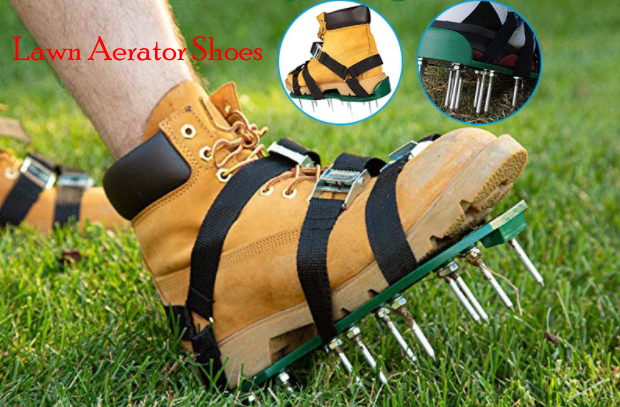Doesn’t it sound great to make your lawn better by walking around in spiked shoes? Perforating hard lawn soil allows air, water, and nutrients to reach grass roots easily. But do lawn aerator shoes work?
According to turf specialists, lawn aerator shoes impact only a small area and don’t really work in reducing soil compaction. Instead, the spikes on the shoes push the soil on the sides and downward, even compacting it more.
What are aerator shoes?
Lawn aerator shoes look like sandals with spikes attached. They have adjustable straps that can hold the sole onto the bottom of your foot, regular shoes, or boots. They come in various sizes to meet the needs of different users.
Aerator shoes are supposed to help aerate the soil by making perforations through which water, air, and nutrients enter to reach the roots of the grass.
To use the aerator shoes, one has to wear and strap them on the shoes and walk around the lawn numerous times. As the body weight exerts pressure on the shoes, the spikes are driven into the lawn, creating small holes when the foot is lifted.
Lawns with clay or silt may get compacted, especially in areas with heavy foot traffic. Closely packed soil particles inhibit air, water, and nutrients from reaching the grass roots. This starves or drowns the plants.
Signs of compacted lawn soil include standing water in the yard and unhealthy turf grass. To test for soil compaction, simply push a screwdriver into the soil. Your soil is compacted if you can’t easily push the screwdriver into the soil.

Do Lawn Aerator Shoes Work?
Aerating shoes can help make holes in the lawn necessary when re-seeding a lawn. However, they are not suitable for reducing soil compaction. This is because they only impact a small lawn area and tend to push soil particles on the sides between the spikes and downwards.
According to the University of Nebraska, aerator shoes will increase compaction for clay or silt soil but may work for lawns with sandy soil. Compacted soil affects lawn quality, growth, and health by decreasing the air in the soil, water, and nutrients infiltration to the grass roots.
There are possible benefits you get when using lawn aerator shoes. They can be helpful during overseeding or application of fertilizer to a lawn. Using aerator shoes can also help control lawn grubs without using chemicals. The spikes actually kill the grubs as you walk around your lawn.
What to use for soil aeration
Soil aeration is an important lawn maintenance process that must be done yearly on lawns with high-traffic areas or heavy clay soils and every 2 to 3 years if you have sandy soil. You need to use the right equipment or tools for the task to get the best results.
Lawn aeration should be done using a plug or core aerator, which uses hollow tines to pull out plugs of soil that are longer and wider. Core aerators perform much better work in breaking up severely compacted soil.
The equipment works similarly to a spike aerator but effectively lifts the plug from the turf other than pushing the soil downward and sideways. The only concern is that a core aerator will leave behind unsightly plugs of soil on the surface of the lawn.
You can rake or use a lawn mower to break up the plugs after they have dried out. These plugs are usually rich in microorganisms, and it’s better if you leave them on your lawn for several days so that the microorganisms can act on the available thatch in your lawn.
When planning to aerate your lawn, water your lawn a day before. This will soften the soil for easier penetration of the aerator. Avoid aerating a heavily soaked lawn, as this may clog the aerator with mud. When aerating, stay away from cables and utility lines in your yard.
Once done aerating, you should thoroughly water your lawn. Some people will prefer to overseed or apply fertilizer after the aeration process. This will depend on the state of your lawn or the time of the year. Check my post on the best time to aerate and oversees a lawn.
What is the best time to aerate a lawn?
Lawn aeration should be done during the period when the grass is actively growing. For cool-season grasses like bluegrass, fescue, and ryegrass, aerate your lawn early in the fall. This is when the grass enters active growth and will still have time to recover before frost.
With warm-season grass like Bermudagrass, St. Augustine grass, and zoysiagrass, aerate your lawns in June and July when the grass is actively growing. Do not aerate during drought or the intense heat of summer.
Final Thought
Watering and fertilizing efforts will not bear fruit if your lawn soil is compacted. You must inspect and aerate your lawn so that water, nutrients, and air get to grass roots. Lawn aeration shoes will not work on heavily compacted soil. Use a plug or core aerator for perfect results.